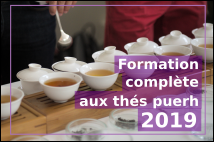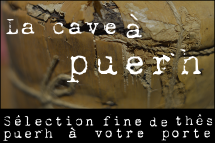 This page is not a real translation but just an automatic translation generated by computer of the original article, written in French language! Its not good... but better than nothing!
This page is not a real translation but just an automatic translation generated by computer of the original article, written in French language! Its not good... but better than nothing!Want to help us do diffuse puerh tea culture in english, by providing a better (or corrected) translation?
Please contact us!

Puerh tea evolves over time, gets better tell fans aged puerh, deteriorates say can be lovers young puerh (Pu Er tea) fresh, always is that it gradually changes from year to year due to complex phenomena oxidation and fermentation taking place at the surface of the leaves.
Or will this oxidation-fermentation is inevitable it is also influenced by the way in which the tea is stored and the conditions under which this maturation take place. Puerh same ages in different conditions and with the result of years gustatorily very different teas. But there is not an established standard that refers to when the ideal way to store tea puerh, and it is also where we find the richness of this family of tea. Different schools coexist and, generally reflecting the tastes and customs of the various jurisdictions in which the tea puerh (Pu Er tea) is consumed as Yunnan, Taiwan, Hong Kong and Malaysia.
I therefore propose to illustrate it to taste good now six puerh (Pu Er tea) 15 years of age, each having a character of its own, and is a reflection of different forms of maturation.
Natural storage, the art of time and nature
We begin with a Tse Chi Cha beeng produced by the famous Fengqing Tea Factory. Pressed in 1996 in the region Fengqing, since this cake was preserved from naturally in the region of production, ie in a real dry atmosphere. Fengqing north of Lincang indeed has a relatively dry climate and comparable to what can be seen in many western regions. The natural maturation that results is so slow and gradual, promotes character centered, a certain purity of flavor and preserve certain attributes of raw puerh.
 Chargement du thé...
Chargement du thé...
We will continue our tasting cake with a large 90s, known by fans and collectors Shui Lan Yin (aquatic blue mark) in reference to a default printer character 茶 which now appears bluish places the green that would be intended, and that identifies the series. This is actually a cake recipe 7542 Menghai Tea Factory produced in 1997.
The cake tasted comes from a natural storage in Taiwan, in a relatively humid atmosphere so. Not to be confused with what is known in Hong Kong and wet storage refers to a form of controlled fermentation puerh (Pu Er tea) tea, this is a natural maturation of tea in a relatively moist atmosphere such as we can have in Hong Kong, Taiwan or Guangzou.
The difference between the maturation of this tea and the tea is therefore in the previous difference between climate Fengqing, drier, and Taiwan, more humid and tropical. This difference in climate has a significant influence on the maturation of tea and how to sculpt his character. More humid atmospheres "denature" (in the good sense) and generally the tea away from its original character, but also favor very nice freshness that can think of camphor or eucalyptus, rendering more particularly dusty or peppery nose, and a certain depth of flavors and sensations. More humid atmospheres generally favor as qi tea, this deep feeling of interaction between tea and senses.
 Chargement du thé...
Chargement du thé...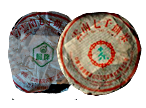
comparatif
1996 Fengqing natural storage vs. dry. Shui Lan Yin 1997 natural wet storage
Although the nature of these two teas seems as worked by the maturation and time, escaping the scent of wet leaves is decidedly more dry, less soft and satiny on Fengqing Cha Chang stored in Yunnan as the Sui Lan Yin stored Taiwan.
Liqueur produced by the infusion of the leaves is also much clearer than for Fengqing Sui Lan Yin, showing a higher level of fermentation for the latter. The Fengqing develops a more fallow, referring to eucalyptus, and a highly pure, where Sui Yin Lan is more steeped in the aromas of natural storage wetter, with splashes of satin and diaphanous.
The Fengqing, nearest to the character of the initial raw puerh (Pu Er tea) also has a more pronounced bitterness, which gives a more frank and sharp. From its side, Shui Lan Yin, seems softer against most penetrating deep meaning, play on the felt.
The dynamic Fengqing also appears an infusion over the other. It takes time and requires a number of infusions to reveal where Sui Lan Yin is more immediate. Similarly Fengqing plays more on the echoes, how the different senses meet, where the Sui Lan Yin is more direct.
The Shui Lan Yin's side has a depth and a unique soft, fragrance complexity and density unusual, a rambunctious charm that saturates the senses and immerses the drinker in the spirit of tea.
Shows two character that is nothing to see, two very different worlds, two interpretations of the effects of time on tea.
If the cake Fengqing no longer has the character of a young puerh (Pu Er tea) taste, this tea has somehow kept the way of expressing a young puerh, its dynamism, its evolution during the tasting, so its to speak in echoes, or where the Sui Lan Yin speaks more like a brown puerh (Pu Er tea) (Hong Kongers storage, storage wet natural, etc. ..), although its taste or any other register.
The Shui Lan Yin spring easier to access, with an incredible charm, direct and immediate, where Fengqing is more difficult to access, requires a bit more time to be, but then a very rich.
Hong Kongers traditional storage, control and art to express the Environment
Now for two teas puerh, respectively in 1996 and 1997, worked with what we nome Hong Kongers traditional storage, or generally known in Hong Kong "wet storage". Behind this name lies a method of controlled maturation tea puerh (Pu Er tea) developed in Hong Kong and typically requires at least 10-20 years to get a mature quality puerh.
The tea is thus no longer subject to ordinary natural conditions of the environment, such as heat and humidity, but goes through different phases where it is exposed so contrôléef to specific conditions, including the level of high humidity to promote fermentation and sculpt its aromas that result. Practiced in Hong Kong for 30 years, this form of storage is a renewed interest in the 90s and some have become real expert in the art of maturation puerh.
If a wet storage of poor quality has little interest, especially today where it is possible to ferment faster puerh (Pu Er tea) production in Yunnan, a Hong Kongers traditional storage quality still allows him to produces high quality puerh, marked by a specific key taste.
Tea that emerges is a fermented tea stored same age naturally, its leaves and liquor are darker and aromas marked by fermentation depart widely from those of young puerh (Pu Er tea) raw. The bitterness is found particularly erased in favor of a thickness, a roundness of a soft and a charm to Hong Kongers storage. In return we note generally reduces dynamic, less subtlety and difference between infusions. Hong Kongers traditional storage is also known to promote qi some teas, teas resulting in deeper, which flatter the senses in depth.
 Chargement du thé...
Chargement du thé...Gouttons now another puerh (Pu Er tea) bulk particularly interesting since it originally comes from the same region as the previous one (Menghai) was produced around the same time can but especially these two teas have spent 15 years in Hong Kong in the same stock. What differentiates these two teas then? Storage conditions slightly different tea previous to 1996 was slightly wetter stored, and that the 1997 edition was deliberately stored so slightly dry to bring out the character of this tea differently. The difference is subtle but significant and is particularly highlighted the complexity of traditional storage Hong Kongers, and the influence that each detail of this storage on the character of the tea that will emerge.
 Chargement du thé...
Chargement du thé...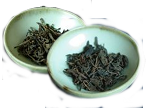
comparatif
Hong Kongers traditional storage more or less dry
There are two bulk years 1996 and 1997 from the same origin and age in Hong Kong in slightly different conditions. Any two from a traditional storage Hong Kongers, a form of maturation laminated in a humid atmosphere, the 1996 vintage has been stored in a slightly wetter, while the 1997 vintage that has been stored under dry slightly, revealing substantially different character of this tea.
The tea liquor produced by 1996 appears to be significantly darker, and denotes a degree of fermentation slightly higher, which is primarily attributed to the difference in storage and not the small year over this tea.
The scent given off by the wet sheets can feel the difference in nature of these two teas, and the influence of storage, tea stored wettest (1996) appear to be more powdery, peppery, where the 1997 is more focused, "purest" of sorts. The same keys aromatic teas are slightly displaced, making more out of 96 keys or 97 wooded there would more think of pistachio.
Tea 1997 driest stored fragrance has a clearer, brighter, but also subtle touches like fresh camphor as its counterpart from 1996 does not have. The latter expresses something in exchange rounder, dull, soft. In one hand (1996) is fuller, fruity sweet, the other (1997) is thinner, cooler.
It is obviously well face the same background character, as a common path that follow these two teas, and the differences between these teas appear as variations antagonists on both sides of the road common that when one of tea right approach, it inevitably moves away from the left and vice versa, when the other tea shoots the left, away from the right
Tea 1996, stored wettest emerges as more exuberant, more direct and charming, or 1997 then stored driest seems a bit more shy and refocused on itself.
As for the tasting, the differences appear gradually erase the specificity of each tea fades somewhat to join on something more common ...
Aged shu Cha, maturation or secondary fermentation of fermented puerh (Pu Er tea)
Now turn to two examples of cha shu , fermented teas during production using a method developed in China in the 70s, inspired by traditional storage Hong Kongers. Unlike previous tea fermentation of these teas is no longer the result of long years of maturation but controlled fermentation requiring only a few weeks.
However, these teas produced in the same year as the other puerh (Pu Er tea) this product have also enjoyed fifteen years of maturation post-fermentation. If this maturation is not in this case due to the fermentation of tea, it is very noticeable in passing a sweeping misconception as what the fermented puerh (Pu Er tea) would no longer have the ability to improve with time.
Quite the contrary, and as we shall see, the cha shu continue to evolve and are also sensitive to the conditions of their maturation, especially cha shu old, usually less than fermented shu cha contemporary. We begin with a fermented tea produced by Lan Ting Chun since 1996 and stored in the Yunnan, in a dry and natural. As we will see, it is a very slow and gradual maturation, during which the tea is made, refocused, without being too deeply stained by the terms of maturation.
 Chargement du thé...
Chargement du thé...
Now for another fermented puerh, one of the famous brick compressed puerh (Pu Er tea) tea produced in 1997 by the Chinese state factories (CNNP). This recipe 7581 tea, as tea before, based heavily on high grade leaves (large leaves) and good potential for them to fermentation. Unlike tea Cha Lan Ting Chang, who has never left the Yunnan, this brick was sent in 1997 to Hong Kong, where she has spent fifteen years in a traditional storage (wet) quality.
As we will see, this form of storage, originally developed in order to ferment the raw puerh, also has a great influence on the maturation of fermented puerh, and deeply sculpted character. Accustomed to the special touches that Hong Kongers storage product that fermentation does not know Chinese imitate many Hong Kongers estimate that the fermented puerh (Pu Er tea) China (shu cha) should always go through a pre-stock Hong Kongers wet before be drunk.
 Chargement du thé...
Chargement du thé...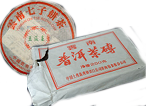
comparatif
Lan Ting Chang Cha 96 vs. dry storage. Hong Kongers storage 97 7581
The scent escaping wet leaves is also quite distinct. The Hong Kongers puerh (Pu Er tea) storage offers a perfume of unequaled power, with an incredible propensity to develop in the nasal cavity, it is misty, dusty and heavily wooded. One is immediately transported into the world of storage teas Hong Kong, exuberant, sweet, powdery, misty.
The aromas and flavors associated with the maturation of the post-fermentation tea Hong Kongers storage are obvious and jump to the taste, especially the wooded dimension seems to have been inflated by storage.
This dimension gives the tea steamy wet storage greater propensity to penetrate deep sense, it is a sensation of tea, or there Lan Ting Chun is stored dry tea flavors. Faced with Hong Kongers tea storage the cake Lan Ting Chang Cha dry storage is much less exuberant, but more sober, focused, pure and fruity.
Conclusion
It is always difficult to generalize when the influence of storage conditions on the puerh (Pu Er tea) tea as it is a broad concept and complex. There are almost as storage conditions of that there's puerh, puerh (Pu Er tea) many more older have them run complex and happened in their lives by various conditions before ending up in the pot, and you can not not always predict the aroma and character developed by a tea not knowing the origin, especially partial.
If it is not to be taken as generalities always satisfied, I will still try to take a few outlines when the influence of ripening conditions on tea puerh, relying on the few examples just drink.
Natural puerh (Pu Er tea) storage is slower than the traditional Hong Kongers storage or other forms of wet storage. Tea 15 years of age stored naturally will be less than fermented tea of the same age from a traditional storage Hong Kongers, or of course a fermented puerh (Pu Er tea) production (Shu Cha). Its leaves are less dark, his liquor clearer and less marked by aromas maturation.
The character of such teas are generally thinner and complex teas whose fermentation has been pushed. Their aromas are fresh and bright, often play in a range suggestive camphor, eucalyptus, see keys pistachio. Stored in natural conditions, these teas are particularly sensitive to indoor climate, and therefore the places where they are stored summers.
Drier climates and slow fermentation, and result in particularly pure teas, processed by maturation in depth without being stained by the latter. Then obtained in fifteen years teas, as Fengqing Cha Chang 1996 that we tasted earlier, which still retain some specific traits of young puerh. If the flavor and character have changed much, we find in the way these attributes are expressed teas young puerh (Pu Er tea) raw as the presence of a certain bitterness that supports tasting, even where a more dynamic way to reveal, leaving the echoes of sensations between the cups. More focused on themselves by these teas can sometimes appear against a bit shy, given the scale and exuberance storage wetter.
Stored naturally in more humid atmospheres such as Hong Kong and Taiwan, as the excellent Shui Lan Yin 1997 we just drink tea fermentation presents a slightly higher, but also specific flavor profiles: Dimension fresh camphor or eucalyptus is often found inflated to take a more prominent, sometimes dominant view in the character of the tea. Not only are more present, this also earns fees universe often rich in complexity, becoming a world to explore taste and produces a real charm to the drinker. The ethereal dimension of teas is then particularly supported with sensations satin or powder in the nose and take their ease occupy the entire nasal cavity. This type of storage also promotes the feeling of cha qi , deep feelings of interaction between tea drinker and beyond the taste. The dimension of taste, if it seems to take more magnitude next to a storage drier is often against more direct, fixed, less dynamic and changing than a tea of the same age stored in a drier atmosphere.
The traditional storage puerh (Pu Er tea) from Hong Kongers are almost a world apart. Maturation is no longer the only result of natural conditions, the result depends in the first place of storage quality and care that has been taken there. Originally used in Hong Kong to ferment faster simply puerh (Pu Er tea) tea without trying to taste as much high quality, some have since developed an art of controlled fermentation puerh (Pu Er tea) tea, and it is in this category Hong Kongers storage for it is now the interest of this approach maturation.
The fermented puerh (Pu Er tea) from Hong Kongers storage quality usually have at least 15 years of age, time wet and dry phases included for fermentation Hong Kongaise quality. Maturation in a Hong Kongers traditional storage is significantly faster than what would be obtained in a natural atmosphere and ventilated tea 15 years of age out of such stock has a stronger fermentation that one stored puerh (Pu Er tea) in the same time natural atmosphere, which is visible both through the color of the leaves or the liquor. Failure to observe the level of fermentation, it will generally be close to a puerh (Pu Er tea) 30 years of age natural storage, puerh (Pu Er tea) or shu (fermented in China) fermentation lightly.
Taste more we move away from the original character of the tea to approach the world of puerh (Pu Er tea) brown, fermented, with aromas much denser and thicker than natural storage allows 15 years. If we find sometimes, as in the Menghai 1997 we have taste, fine traces of camphor freshness, they are more predominant but integrated into a more rounded, soft and warm. If we keep the sensations satin powder, which sometimes becomes almost exuberant, it is generally busiest freshness but specific flavors developed by fermentation such as wood, producing soft, typical of this family of tea. The same bitterness is generally very small, see totally absent, and is replaced by deep woody notes more or less marked.
When storage is good, sometimes it also promotes the development of cha qi deeper and intense and good potential to play on the emotions of the drinker. Emerges something that fits perfectly into Hong Kongers taste, teas round, soft, warm and soothing the mind and body. If these teas generally offer a much greater finesse to shu cha, their rich taste and vitality back often remains face dry good storage.
Largely dependent on the hand of man, but also the quality of the character of such teas is usually a direct reflection of the quality of the storage and care that has been provided. Mismanagement of storage conditions, but also a revival sloppy or too short will result in teas having little interest. But even in a quality storage, each choice from the head of stock will be important, as we have seen a slight variation of moisture over a few years will lead to significantly different teas. Hong Kongers storage, although it has a taste recognizable character, is not given to all tastes, but a category of maturation in which we find things of character and quality differ depending on the house where tea is out and the conditions under which the tea was stored.
The cha shu , fermented in China by the method Wo Dui is a family of puerh (Pu Er tea) full. Before being pressed and possibly stored these teas have undergone rapid and extensive fermentation, usually about 1 to 2 months, which equates to a level of fermentation in which several decades of natural storage would be necessary. Teas that emerge are therefore generally higher level of fermentation that teas of the same age from storage natural or traditional Hong Kong people, but also a different flavor profile.
Although it can be consumed immediately, these teas continue to evolve over time, and therefore, as are raw puerh, sensitive to the conditions in which they live their maturation. Course teas are fermented already fully the role of maturation will no longer fermentation leaves either, but a form of post-ripening fermentation, where the aroma produced by the fermentation will arise, balance, sometimes swelling in this or that direction, and finally put it another way ... This is all the more striking for fermentation light as they were practiced in the 70 to 90, which leaves a greater role in the maturation or post-fermentation fermentation there as we further the practical now generally offer less room to work time.
Stored as dry as the Tse Chi Lan Ting Chun Cha beeng 1996 These teas tend to focus on themselves and ask. They retain and magnify purity with the specific flavor of fermentation Chinese emphasize the delicacy and richness of fruit or nut keys or wood carved by fermentation, while separating the red that their youth and providing new equilibrium.
Stored carefully in a more humid in a good traditional storage Hong Kongers example, a key acquire these teas taste typical Hong Kongers, a characteristic soft, more size, more strength distribution including the nose, and greater sense of depth. It will include the powdery and satin storage Hong Kongers, but often cha qi deeper, penetrating and soothing impression. On the other hand this form of storage distorts more the character of the tea, and favors can sometimes feel the taste, tea producing more with less purity and aromatic finesse.

